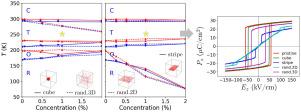(Ba,Sr)TiO3中点缺陷设计——对团聚的认识
IF 9.3
1区 材料科学
Q1 MATERIALS SCIENCE, MULTIDISCIPLINARY
引用次数: 0
摘要
铁电体的功能特性及其随时间的变化在很大程度上取决于缺陷结构。特别是由缺陷偶极子引起的点缺陷和偏置场改变了场滞回,对疲劳和老化起着重要的作用。然而,对于缺陷偶极子的有序、团聚和强度对相稳定性和功能特性的影响仍缺乏充分的认识。为了弥补这些知识上的空白,我们利用有效哈密顿方法对原型铁电材料(Ba,Sr)TiO3进行从头算分子动力学模拟,筛选这些参数。我们的研究结果表明,缺陷的活性表面积,而不是缺陷的浓度是决定性因素。在缺陷浓度固定的情况下,聚类减少了活性表面积,从而减少了缺陷引起的相稳定性和场滞回的变化。特别是平面缺陷团块,由于其对场迟滞的影响可以通过场方向来控制,并且其对相稳定性的影响与缺陷偶极子的强度呈交叉关系,因此在材料设计中显得很有前途。对于这种团聚,我们表明,即使在原始(Ba,Sr)TiO3的准电相中,由于压缩双回线场滞后,可恢复的存储能量也可以优于原始(Ba,Sr)TiO3的响应。本文章由计算机程序翻译,如有差异,请以英文原文为准。


Point defect design in (Ba,Sr)TiO3—An insight on agglomeration
Functional properties of ferroelectrics and their changes with time depend crucially on the defect structure. In particular, point defects and bias fields induced by defect dipoles modify the field hysteresis and play an important role in fatigue and aging. However, a full understanding on how order, agglomeration and strength of defect dipoles affect phase stability and functional properties is still lacking. To close these gaps in knowledge, we screen these parameters by ab initio based molecular dynamics simulations with the effective Hamiltonian method for the prototypical ferroelectric material (Ba,Sr)TiO. Our findings suggest that the active surface area of the defects, rather than the defect concentration is the decisive factor. For a fixed defect concentration, clustering reduces the active surface area and thus the defect-induced changes of phase stability and field hysteresis. Particularly planar agglomerates of defects appear as promising route for the material design as their impact on the field hysteresis can be controlled by the field direction and as their impact on the phase stability shows a cross-over with the strength of the defect dipoles. For this agglomeration, we show that the recoverable stored energy can outperform the response of pristine (Ba,Sr)TiO even in its paraelectric phase due to a pinched double-loop field hysteresis.
求助全文
通过发布文献求助,成功后即可免费获取论文全文。
去求助
来源期刊

Acta Materialia
工程技术-材料科学:综合
CiteScore
16.10
自引率
8.50%
发文量
801
审稿时长
53 days
期刊介绍:
Acta Materialia serves as a platform for publishing full-length, original papers and commissioned overviews that contribute to a profound understanding of the correlation between the processing, structure, and properties of inorganic materials. The journal seeks papers with high impact potential or those that significantly propel the field forward. The scope includes the atomic and molecular arrangements, chemical and electronic structures, and microstructure of materials, focusing on their mechanical or functional behavior across all length scales, including nanostructures.
 求助内容:
求助内容: 应助结果提醒方式:
应助结果提醒方式:


